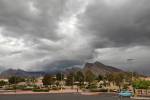Super typhoon churns toward the Philippines
A massive, menacing storm system dubbed Super Typhoon Maysak churned in the Pacific Ocean on Wednesday, days away from a possible direct hit on the Philippines.
Maysak churned west-northwest at around 11.5 mph after skirting the Federated States of Micronesia, according to the U.S. Joint Typhoon Warning Center. Its eye is projected to make landfall in the central or northern part of the Philippine island of Luzon on Sunday, though the country’s residents could start feeling its effects days before.
That could mean those celebrating Easter in the predominantly Catholic nation may be socked by heavy rains and potent winds, with the International Red Cross noting that “many people are expected to throng coastal areas at this time.”
While much can change between now and then, as of Wednesday evening, this cyclone is already powerful. Its maximum sustained winds are 150 mph (which would make it a strong Category 4 on the Saffir-Simpson scale), with gusts up to 185 mph. The Joint Warning Center considers storms that have such high winds a Super Typhoon.
Filipinos are no strangers to typhoons. In December, for instance, Hagupit killed at least 25 people in the East Asian nation.
But that devastation paled in comparison to the havoc wrought by Super Typhoon Haiyan in November 2013, which killed more than 6,000 people, injured more than 27,000 others and forced 3.9 million people from their homes. That typhoon — considered by some to be among the strongest such storms to make landfall — hit the Leyte province city of Tacloban especially hard.
The irony of the upcoming storm is when it’s coming: in April, just after the Philippines Atmospheric Geophysical and Astronomical Services Administration officially declared the onset of the nation’s dry, or summer, season.
PAGSA meteorologist Shelley Ignacio predicts Maysak — which is called Chedeng in the Philippines — will bring heavy rains to Luzon starting on Friday, according to the state-run Philippines News Agency (PNA). She noted that the storm had weakened a bit due to sea surface temperatures.
The country’s National Disaster Risk Reduction and Management Council went on red alert on Wednesday because of the storm, PNA reports. That alert means all relevant personnel are on standby and the public should be on guard for possible effects of the storm.





























